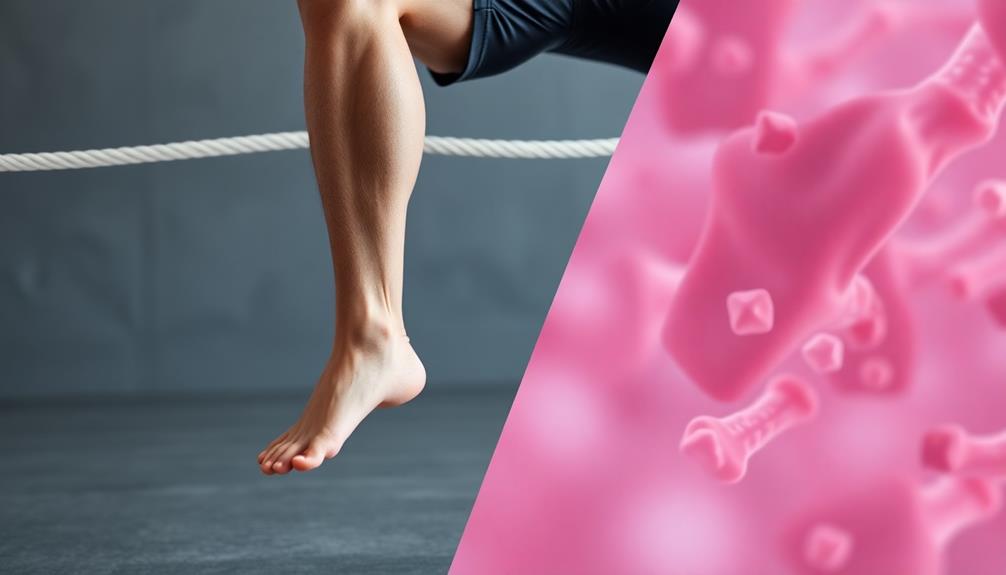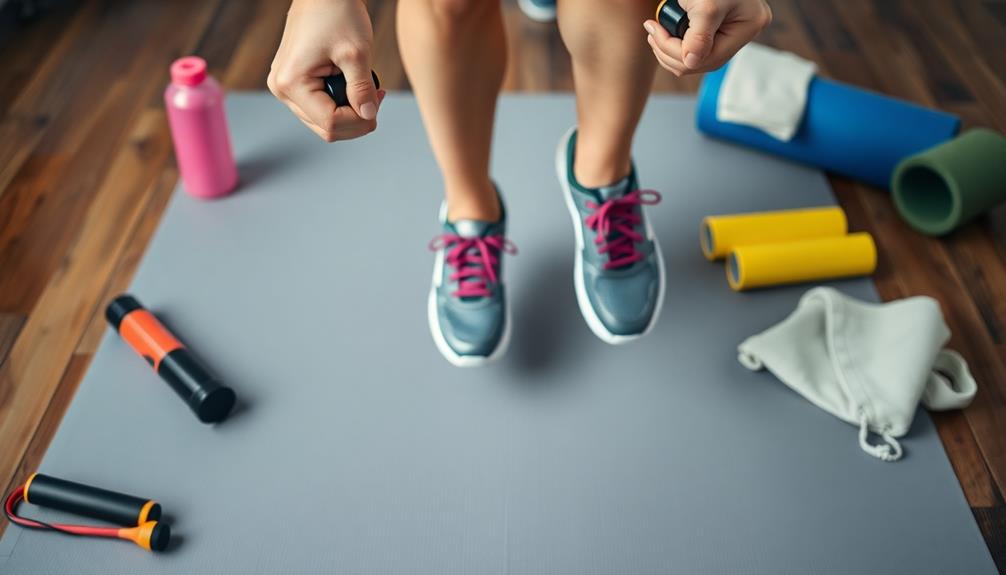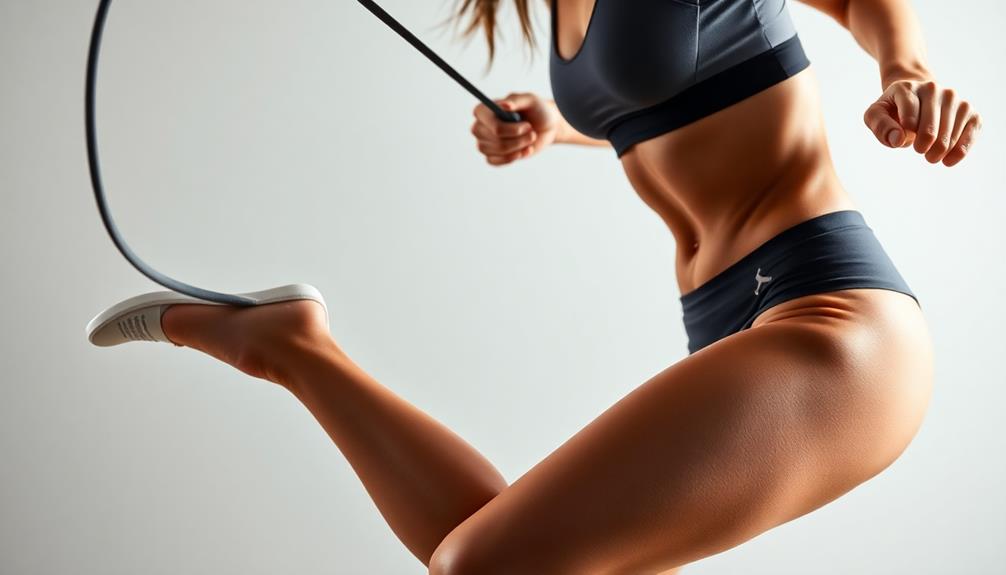Jump roping builds muscle through a combination of stress and adaptation. As you jump, you're creating tiny tears in your muscle fibers, which then repair and grow stronger. This full-body workout targets your legs, core, and even upper body muscles. To get started, choose the right rope length and wear supportive shoes. Focus on proper technique: land softly on the balls of your feet with knees slightly bent, engaging your core. Gradually increase workout duration and intensity to apply progressive overload principles. For maximum muscle growth, incorporate strength training exercises and pay attention to nutrition and recovery. The following steps will guide you through maximizing your muscle-building potential with jump rope.
Core Insight
- Jump roping causes micro-tears in muscle fibers, leading to repair and growth during recovery.
- Engaging multiple muscle groups simultaneously promotes overall muscle development and strength.
- Gradually increase workout duration and intensity to apply progressive overload principles for muscle growth.
- Incorporate variations like weighted ropes or different surfaces to challenge muscles in new ways.
- Maintain proper technique and form to maximize muscle engagement and prevent injury during workouts.
The Science Behind Muscle Building

Jumping rope is a great way to build muscle strength. When you jump, your muscles are put under repeated stress, especially in your legs and core. This stress causes tiny tears in your muscle fibers. But don't worry, this is actually a good thing!
Your body fixes these small tears when you rest. This makes your muscles stronger than before. The more you jump rope, the more your muscles will adapt and grow to handle the extra work. This leads to stronger muscles and better endurance.
Jump roping works many muscle groups at the same time. This helps build muscle all over your body. It's an intense but low-impact exercise that's easy to add to your routine. By changing up your jumping style and making your workouts longer or harder, you'll keep challenging your muscles and helping them grow.
Essential Jump Rope Equipment

Choosing the right jump rope is crucial for an effective workout. Make sure the rope is the correct length for your height. When you step on the middle of the rope, the handles should reach your armpits. A foam roller can help with muscle recovery and flexibility.
Jump ropes come in different types:
- Speed ropes: Lightweight, perfect for fast workouts
- Weighted ropes: Build arm and shoulder strength
- Beaded ropes: Durable, great for outdoor use
Wear comfortable, supportive shoes with good cushioning to protect your joints. Jump on a smooth, flat surface. A yoga mat or thin exercise mat can reduce impact on hard floors.
Proper Jump Roping Technique

Proper Jump Roping Technique
Jump roping is a great full-body workout when done correctly. Stand with your feet together and hold the rope handles at your hips. Keep your elbows in and your shoulders relaxed. Use your wrists to swing the rope over your head and jump when it gets to your feet. To help your muscles recover and stay flexible, try using a foam roller after your workout.
Land gently on the balls of your feet and keep your knees slightly bent. Don't jump too high, just 1-2 inches off the ground. Stand up straight and engage your core. As you get better, try switching feet or doing high knees.
Don't forget to breathe evenly during your workout. Begin with short intervals and slowly increase your time as you build endurance. Keep at it to perfect your technique and get the most out of jump roping for building muscle.
Targeted Muscle Groups

Jumping rope strengthens muscles all over your body, especially your legs. Your calves, quads, and hamstrings work hard as you bounce and land. Wearing compression sleeves on your legs can help your muscles recover faster and perform better.
Your abs, lower back, shoulders, and arms also get a workout when you jump rope. Keeping your balance engages your core, while using a weighted rope challenges your upper body. Even your chest and upper back muscles activate to maintain good posture.
Progressive Overload Principles

To build muscle with jump rope, you need to make your workouts harder over time. This is called progressive overload. Start by jumping for longer. Then, jump faster or try harder moves. You can also use compression sleeves to support your muscles and recover better.
Another way to make it harder is by using weighted ropes or ankle weights. Start light and slowly increase the weight as you get stronger. Jumping on different surfaces, like going from soft to hard, can also challenge your muscles in new ways.
Incorporating Strength Training Exercises

Strength training is the perfect partner for jump rope workouts when it comes to building muscle. To get the most out of your efforts, add bodyweight exercises and resistance training to your routine. Squats, lunges, and push-ups are great for targeting the main muscle groups. They'll help you build strength and stability all over, which will boost your jump rope performance. For an even better workout at home, think about getting a TRX system. They're versatile and easy to take with you.
Next, bring in resistance bands or dumbbells. Do bicep curls, shoulder presses, and rows for a stronger upper body. Deadlifts and calf raises will focus on your lower body. These moves will add to the cardio and endurance benefits you get from jump roping.
Make sure you use the right form and slowly increase the weight or resistance as you get better. Try to do strength training 2-3 times a week, switching off with your jump rope sessions. This balanced approach will help you build muscle effectively and improve your overall fitness.
Nutrition for Muscle Growth

Eating right is key for building muscle when you combine jump rope with strength training. To build muscle, eat enough protein. Aim for 1.6 to 2.2 grams per kilogram of body weight each day. Eat lean meats, fish, eggs, beans, and tofu. Protein bars can be handy snacks before or after workouts to help muscles grow and recover.
Don't skip carbs, which fuel your workouts and recovery. Go for whole grains, fruits, and veggies. Healthy fats from avocados, nuts, and olive oil are also important, but don't overdo it.
Drink lots of water all day long. Try to eat a balanced meal with protein and carbs before and after you exercise. This will help your muscles grow and bounce back.
Recovery and Rest Importance

Recovery and rest are crucial parts of your jump rope routine. They help your muscles grow and improve your performance. When you exercise, your muscles get stressed. Your body needs time to fix and strengthen these muscles. One good way to recover after a workout is to take ice baths. They can reduce swelling and help your muscles heal faster.
Try to get 7-9 hours of sleep each night. This helps your muscles recover and keeps your hormones in balance. Make sure to include rest days in your workout plan. Wait at least 48 hours between intense jump rope sessions. On rest days, do light activities like stretching or walking. This improves blood flow and reduces muscle soreness.
Low-intensity jump roping can also help your muscles heal. This is called active recovery. Pay attention to your body and change your routine if needed. Remember, recovery isn't just about resting your body. It's also about resting your mind. This helps you stay motivated and focused on your fitness goals.
Tracking Progress and Results

Tracking your progress is key to getting the most out of your jump rope workouts. Start a workout log and write down how long you jump for, the number of jumps you do, and the exercises you complete. Pay attention to how hard the workout feels and how your body feels after. Taking progress photos every few weeks can help you see changes in your muscle and body composition.
To check your cardiovascular fitness, time yourself jumping rope without stopping. You can also count how many jumps you finish in a set amount of time. As your endurance and coordination get better, these numbers will improve. Remember to review your goals from time to time. Make changes to your jump rope routine as needed to keep making progress.
Frequently Asked Questions
Can Jump Roping Help With Weight Loss as Well as Muscle Gain?
Yes, jump roping can help you lose weight and build muscle. It's an excellent cardio workout that burns calories and improves your metabolism. As you jump, you'll engage multiple muscle groups, leading to increased strength and tone.
Is Jump Roping Suitable for People With Joint Issues or Injuries?
If you have joint issues or injuries, jump roping might not be suitable for you. It's a high-impact exercise that can stress your joints. You'd better consult your doctor or physical therapist before starting any new exercise routine.
How Long Does It Take to See Noticeable Muscle Gains From Jump Roping?
You'll typically notice muscle gains from jump roping within 4-8 weeks, depending on your consistency and intensity. If you're jumping regularly and challenging yourself, you'll see improvements in your leg and core muscles sooner.
Are There Any Age Restrictions for Using Jump Rope for Muscle Building?
You'll find that jump rope is suitable for most ages. There aren't strict age restrictions, but you should consider your fitness level and any health conditions. It's always best to consult your doctor before starting any new exercise routine.
Can Jump Roping Replace Traditional Cardio Exercises in a Workout Routine?
Yes, you can replace traditional cardio with jump roping in your workout routine. It's an effective, high-intensity exercise that burns calories, improves endurance, and boosts cardiovascular health. You'll get similar benefits to running or cycling, with less impact.

